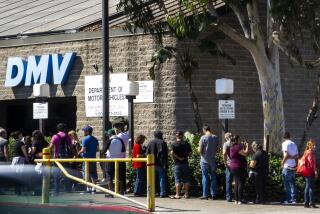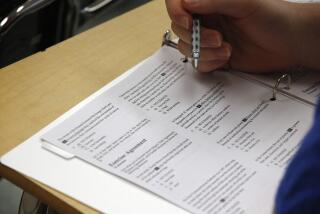CAMPUS & CAREER GUIDE : Re-Examination : Computers: Put away those No. 2 pencils. On-line test-taking offers scheduling convenience and privacy. And the score pops up within minutes.
- Share via
Two cozy rooms in a Santa Monica storefront are now beachheads in a revolution that promises to overthrow traditions in the nerve-racking business of educational testing.
At the Sylvan Learning Center’s comfortably furnished branch on Santa Monica Boulevard, college students and mid-career switchers are among the first people in the nation to take a new, computerized version of the Graduate Record Examination, the crucial test for graduate school applications.
No more filling in the bubbles with No. 2 pencils. No more cramming into chilly auditoriums or school gymnasiums with 500 other anxiety-stricken test-takers. No more agonizing six-week waits for . . . The Score.
Instead, this year about 40,000 people--or 10% of the GRE candidates nationwide--will have the convenience of scheduling their exams for almost any day of the year. Toiling with a computer keyboard and mouse, they can finish the exam in a third less time than if they took it the old-fashioned way. The atmosphere will be more private. And the score pops on the screen within minutes.
“I think people will learn about it and I think it’s just going to become accepted,” Karen Gregory, executive director of the center, said of the so-called computer-adaptive GRE which debuted in November.
Officials believe nearly all GRE tests will be taken on computer within five years. Professional licensing exams, such as for nursing and architecture, are next to join the computer age. But educators say the trend still faces resistance from tradition-bound test-takers uncomfortable both with the technology and with a profound change in the nature of the test.
The new GRE is more than just a keyboard-and-mouse substitute for the old pencils-and-fill-in-the-bubble answer sheets. It radically alters testing by pegging the difficulty of successive questions to the previous right or wrong response to a word or math problem. A person who gives correct answers to ever-more-difficult questions could complete the exam in as little as two hours and 15 minutes, compared to 3 1/2 hours for the traditional format. The number of questions could be reduced by a third from the written exam.
The individualized nature of the new exam also could thwart cheating because most candidates will not trigger identical patterns of questions.
But to the chagrin of some students, each question must be answered before a test-taker can move on. This kills the familiar strategy of skipping the most challenging questions to save time.
“The results so far are encouraging that this will be a transition easily accepted by the test-taking population,” said Richard Attiyeh, dean of graduate studies and research at UC San Diego. “I haven’t so far seen any negative student response, but it’s still early and it may well be that the students who chose to take it are more inclined to be positive.”
Several convenient features already are proving popular even though, at $93, the computerized test costs nearly twice what the traditional paper exam does.
One of the advantages is that the computerized test can be taken year-round, compared to the traditional paper-and-pencil exam offered only five times a year. Now, 125 test centers across the country, mainly in the Sylvan chain and on some college campuses, offer computerized GREs; another 75 centers are to be added by April.
The new test announces scores a minute or so after completion, compared to the four to six weeks of nervous waiting for the regular test results by mail. (The GRE has three parts--verbal, quantitative and analytical. As with the Scholastic Aptitude Test for undergraduate admissions, each GRE section is graded on a scale from 200 points to a perfect 800.)
*
Early on, some educators expressed concern that people not familiar with computers might do worse on the test than the computer literate. What’s more, the test requires use of a personal computer mouse, something that not all home computer owners have. And some people are rattled by the new format that allows no skipping and that constantly seems to make judgments about their intelligence.
“If the questions get easier, psychologically you know you are doing badly,” said San Francisco resident Karen Kerr, 25, who took the test a few months ago.
Kerr, who wants to enroll in an education graduate program, fears that she performed below her abilities as a result of the pressure she felt from the computer. She also found it difficult to scroll through reading texts and to look back and forth from the computer screen to a scratch pad for math problems. She wound up not answering enough questions and now has to retake the test.
On the other hand, Karen Solomon, a Cal State Northridge student, recently took the computerized GRE at the Santa Monica Sylvan center rather than a written version that conflicted with her regular final exams. At first, she felt anxious about the technology, yet soon mastered it and came to enjoy the privacy it provided.
“I thought I’d have more difficulty,” said Solomon, who is applying to graduate programs in social work. The biggest change from written tests, she said, is that the adaptive exam forces you to guess more--”it feels like more of a game.”
Such difference of opinion is natural, said Hudhail Al-Amir, director of USC’s testing bureau.
“Not everyone is comfortable with computers. There is always that fear in some people’s mind that they are going to hit the wrong button and wipe out everything,” he said. He expects such fears to lessen with each passing crop of graduate school applicants.
Such concerns have been extensively examined, according to Nancy Cole, president of the Educational Testing Service, the New Jersey-based organization that developed and sponsors the GRE. In trial runs, special attention was paid to older and low-income students who might not have much computer experience.
“What we found was that the older students coming back to school tell us they are a little nervous about taking it on computer,” Cole said in a recent telephone interview. “But then we find they don’t do any worse than anyone else.” In fact, she added, older students are taking the computerized test in disproportionately large numbers because they like the chance to schedule it around their work hours.
As for younger students without computers at school and home, the introductory half-hour tutorial usually puts them at ease quickly, Cole added. “We’re confident that we’ve got it working and working well,” she said. “We really believe computer-based testing will be with us from now on.”
The SAT, which 1.8 million high school students take each year, will eventually switch at least partly to computers, officials said. But there are not enough computer centers for such volume now. Meanwhile, the GRE’s computer revolution is to spread to other national standardized tests this year, such as licensing exams in nursing, teaching and architecture.
Joseph Duggan, associate dean of UC Berkeley’s graduate division, said he has been impressed by what he has seen of the new GRE. Still, he thinks it is a tad premature to pronounce the computerized version free of any possible built-in discrimination. “It’s not that I lack confidence in (the testing service’s) ability to do this kind of thing, but I think I’d like to see some more results after massive test-giving over the next year or two,” he said.
*
No such doubts linger among the people who offer the new GREs twice a day, Monday through Saturdays, at the Sylvan Learning Center in Santa Monica.
Two rooms have been set up with a total of nine work stations, each equipped with a five-foot-long desk, a well-padded roller chair, an antique-style lamp, an IBM computer and a side divider for privacy. A tiny clock on each screen reminds test-takers how much time is left for each exam section and the minimum number of questions they must still answer. “The environment is so much more conducive for test-takers to do the best they can do,” said center director Gregory.
It may also be a more cheat-proof setting.
A proctor monitors the rooms through windows and video cameras unobtrusively scanning the test rooms. Intercoms of the type designed to pick up an infant’s cries are used to listen to any conversations. A video photo of each candidate is taken before the test and a copy is recorded with the scores, to help prevent a stand-in from taking the test over for a student who does poorly the first time.
Emily Allen, technology coordinator there, said potential test-takers often question her nervously about the new format.
“All the people who have called up ahead of time fearful about it and then have taken it have been very happy about it,” she recalled. “They haven’t had any catastrophes. . . . So that makes me more able to reassure anyone who calls that you don’t even have to know anything about computers to take it.”
More to Read
Sign up for Essential California
The most important California stories and recommendations in your inbox every morning.
You may occasionally receive promotional content from the Los Angeles Times.










